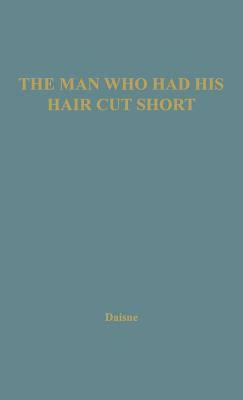 You can rest assured that a novel titled THE MAN WHO HAD HIS HAIR CUT SHORT won’t ever be mistaken for (say) ENTRAILS OF THE VIRGIN. Written by the acclaimed Belgian author JOHAN DAISNE, it was published in 1965 by Horizon Press, the first English translation of a highly literate exercise in subjective insanity—and make no mistake: THE MAN WHO HAD HIS HAIR CUT SHORT is literary with a capital L.
You can rest assured that a novel titled THE MAN WHO HAD HIS HAIR CUT SHORT won’t ever be mistaken for (say) ENTRAILS OF THE VIRGIN. Written by the acclaimed Belgian author JOHAN DAISNE, it was published in 1965 by Horizon Press, the first English translation of a highly literate exercise in subjective insanity—and make no mistake: THE MAN WHO HAD HIS HAIR CUT SHORT is literary with a capital L.
It starts out in riveting fashion, with the elderly male narrator recalling his days as a schoolteacher, when he fell in love with a teenage seductress who rebuffed his advances and left him devastated. A decade later the guy, after witnessing a gruesome dissection, runs into the now grown-up girl and the two have a most revealing conversation. This is followed by a gruesome jolt of nastiness and a denouement that suggests everything we just read may have been the projection of an unreliable narrator.
As I said, the novel is interesting at first but quickly loses its allure, with the relentlessly verbose descriptions growing increasingly tiresome. There’s also the fact that the entire text is told in a single unbroken paragraph, which gives it a breathless tone that never wavers, and it was the one-note feel that annoyed me the most.
For a tonic to the suffocating pretentions of the above check out the Japanese GUTS OF A BEAUTY (BIJO NO HARAWATA) from 1986, a film that can be 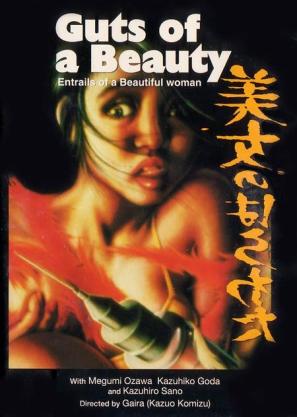 confused with the aforementioned ENTRAILS OF THE VIRGIN. GUTS OF A BEAUTY, after all, was made by the same director—Gaira, a.k.a. Kazuo Komizu—and in the same year—1986—as ENTRAILS.
confused with the aforementioned ENTRAILS OF THE VIRGIN. GUTS OF A BEAUTY, after all, was made by the same director—Gaira, a.k.a. Kazuo Komizu—and in the same year—1986—as ENTRAILS.
In GUTS OF A BEAUTY’S opening scene a gang of depraved mobsters gang rape a young woman. Even though she seems to enjoy the ordeal, and even begs for more at one point, she commits suicide afterward. The female doctor who treated the rape victim feels bad and embarks on a revenge-minded murder spree. The gangster-rapists in turn give the doctor an overdose of a new super drug that turns her into a grunting, fleshy monster who kills ‘em all with its giant penis (equipped with a snapping mouth and teeth).
Narratively there’s a bit too much going on, but the pic contains enough grossness and perversion to satisfy the most demanding sleaze maven, including beheadings, necrophilia, spurting blood and a penis bursting through a woman’s stomach—if you thought nothing could top the iconic ALIEN chest-burster, think again!
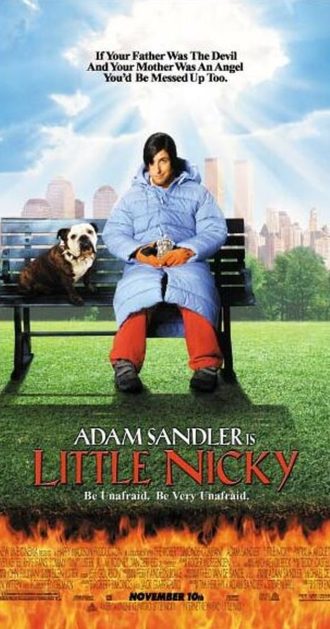 More crazy-fantastic, albeit far less startling or grotesque, imagery can be found in the 2000 Hollyweird product LITTLE NICKY, an $80 million FX-filled bomb starring Adam Sandler as one of Satan’s three sons. He’s stationed on Earth to keep his brothers from taking over, leading to a lot of quintessentially Sandler-esque hijinks, albeit presented on a far grander scale than any of his previous flicks (these days LITTLE NICKY actually plays like a dry run for 2015’s PIXELS, which wasn’t much better).
More crazy-fantastic, albeit far less startling or grotesque, imagery can be found in the 2000 Hollyweird product LITTLE NICKY, an $80 million FX-filled bomb starring Adam Sandler as one of Satan’s three sons. He’s stationed on Earth to keep his brothers from taking over, leading to a lot of quintessentially Sandler-esque hijinks, albeit presented on a far grander scale than any of his previous flicks (these days LITTLE NICKY actually plays like a dry run for 2015’s PIXELS, which wasn’t much better).
The flick, featuring numerous high profile cameos by the likes of Regis Philbin, Jon Lovitz and Quentin Tarantino, was the first of Sandler’s movies to bomb. I’m not at all surprised, although I am a bit puzzled as to how anyone could have thought it would ever make money.
Few people, to my knowledge, were too surprised about the non-reaction to TWO, a 1974 no-budgeter written, produced, 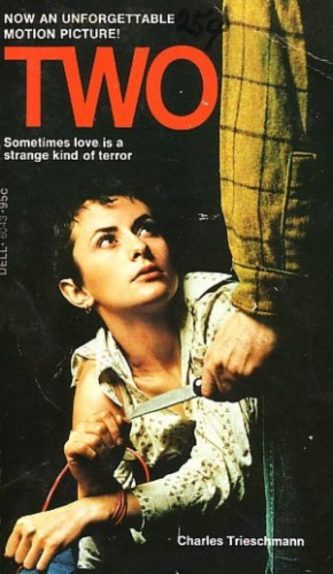 directed and edited by CHARLES TRIESCHMANN. He’s also credited with writing a tie-in novel (the credits read “Screenplay and Novel by Charles Trieschmann”) that’s better written than you might expect, with a convincing grasp of female psychology.
directed and edited by CHARLES TRIESCHMANN. He’s also credited with writing a tie-in novel (the credits read “Screenplay and Novel by Charles Trieschmann”) that’s better written than you might expect, with a convincing grasp of female psychology.
The TWO novel is certainly superior to the movie (which was released on VHS under the title CAPTIVE), a routine variation on the tried-and-true COLLECTOR formula involving a disturbed Vietnam vet kidnapping a young woman and holding her hostage in a deserted cabin. Some exploitation might have livened things up, but Trieschmann tries, and fails, to craft a love story out of this very unlikely premise. At least the book, at 139 pages, is a quick and relatively painless read that goes down far better than the movie’s bloated 93 minute runtime.
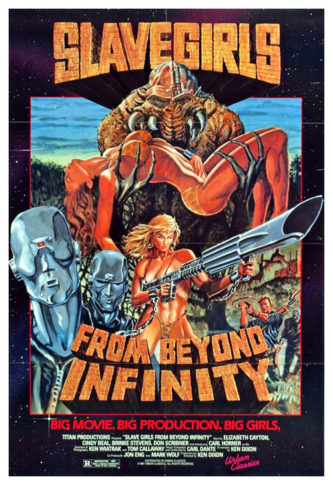 Thankfully the 1987 trash-fest SLAVE GIRLS FROM BEYOND INFINITY only runs 80 minutes. During my teenage years I proudly displayed a copy of this movie’s fabulously lurid one-sheet, sporting what I consider one of the all-time great trash movie titles and irresistibly lurid artwork that depicted big-titted chicks with even bigger guns being menaced by toothy critters—evidently a case where the title and poster were conceived before the script was written.
Thankfully the 1987 trash-fest SLAVE GIRLS FROM BEYOND INFINITY only runs 80 minutes. During my teenage years I proudly displayed a copy of this movie’s fabulously lurid one-sheet, sporting what I consider one of the all-time great trash movie titles and irresistibly lurid artwork that depicted big-titted chicks with even bigger guns being menaced by toothy critters—evidently a case where the title and poster were conceived before the script was written.
The movie itself, about slave babes (trash movie queen Brinke Stevens among them) being hunted MOST DANGEROUS GAME-style on a distant planet, is, if anything, a bit too slick for its own good. Yet SLAVE GIRLS FROM BEYOND INFINITY is conversely not good enough to qualify as legitimate movie entertainment (even of the grade-B variety), leaving it stranded in that most unforgivable of categories: mediocre.
The great title/not-so-great flick combo was repeated in 1991’s LOINS OF A VAMPIRE, a European porno that cannot be called mediocre. Rather, it falls squarely in the overtly shitty category.
Set in and around a Romanian castle, it features a chick in witch garb, another dressed like a mouse, and another like Santa Claus (complete with a beard!), along with a guy wearing a rabbit’s head mask, a vampire and a mummy. The proceedings, as you might guess, consist largely of protracted hard core sex scenes, set to Jean-Michele Jarre’s electronic muzak. It may have contained an honest-to-goodness story at one point (a cover blurb claims it was “Previously Banned in the U.S.A.”), but it’s been truncated by all-too-evident re-editing for American release. One thing, however, is certain: Jean-Michele Jarre’s tunes play astonishingly well over porno imagery.
Further confirmation of the power of sound, radio in this case, is offered by the infamous October 30, 1938 “Panic Broadcast” of WAR OF THE WORLDS by 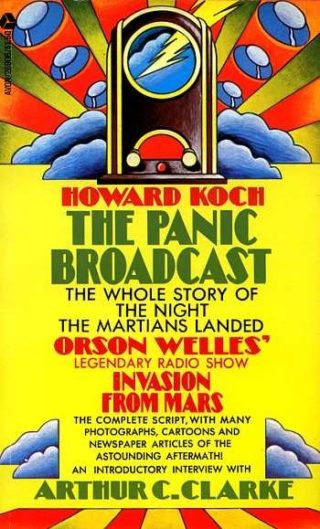 Orson Welles, scripted by HOWARD KOCH. Koch also authored THE PANIC BROADCAST in 1970, an informative nonfiction tome that tells the full story of the broadcast and its aftermath.
Orson Welles, scripted by HOWARD KOCH. Koch also authored THE PANIC BROADCAST in 1970, an informative nonfiction tome that tells the full story of the broadcast and its aftermath.
The book contains copious newspaper clippings detailing the reactions of hundreds of ordinary Americans who thought the broadcast was real, resulting in a flood of panicked calls to police stations across the country and at least one suicide attempt. Koch also includes the complete WAR OF THE WORLDS script, as well as a remembrance of a visit he and his wife took to Grovers Mill, NJ, the spot where the fictional invasion took place (a location, Koch claims, he picked at random), and a quickie interview with the late Arthur C. Clark, who claims that an extraterrestrial race capable of traveling through space would most likely have other things on their minds outside of destroying the Earth.
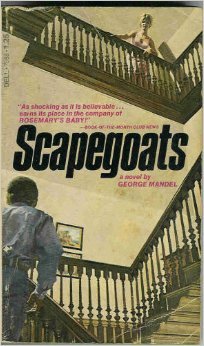 A far less auspicious piece of American history can be found in the form of the 1970 novel SCAPEGOATS by GEORGE MANDEL. Its historical value is in its outrageously politically incorrect (and frankly pretty ridiculous) storyline, which would NEVER fly with today’s publishers (the novel, unsurprisingly, hasn’t been reprinted in over 40 years).
A far less auspicious piece of American history can be found in the form of the 1970 novel SCAPEGOATS by GEORGE MANDEL. Its historical value is in its outrageously politically incorrect (and frankly pretty ridiculous) storyline, which would NEVER fly with today’s publishers (the novel, unsurprisingly, hasn’t been reprinted in over 40 years).
The book concerns a lily-white housefrow whose idyllic life is invaded one morning by a black man who breaks into her house claiming he was contracted to assassinate her. Spanning a period of about six hours, it’s a VERY tightly wound, claustrophobic account, with the heroine’s every action accompanied by minutely detailed psychological observations, which more often than not detract from the overall effect. Still, it’s a uniquely twisted read, outrageous and, again, extremely politically incorrect: the black intruder rapes his white captive repeatedly, and she inevitably comes to enjoy it, even going so far as to turn the tables and instigate the sex play herself.
Racist? Probably.
Sexist? Probably.
Readable? Mostly.
